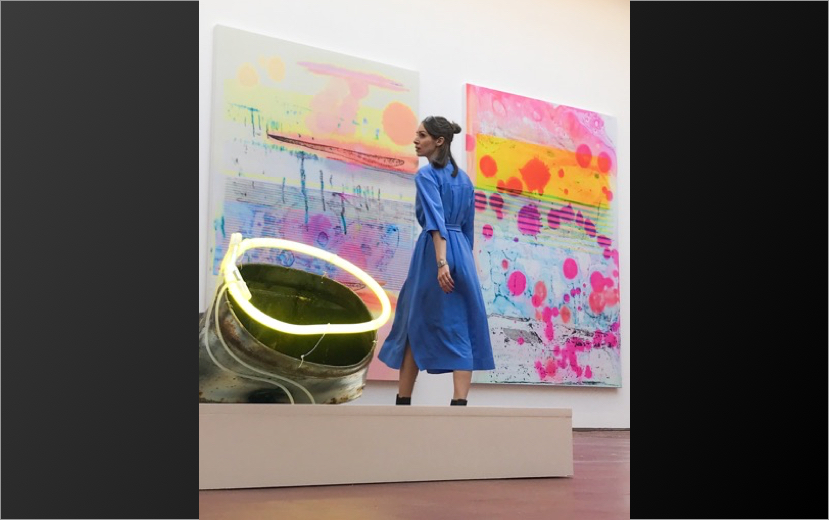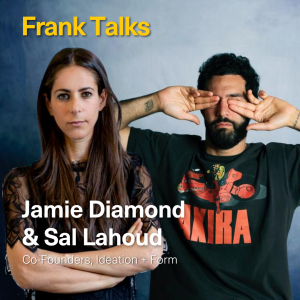Alexa Brossard is the director of ARTUNER, the innovative curatorial and digital platform founded in 2013 by collector & entrepreneur Eugenio Re Rebaudengo. ARTUNER has a hybrid approach: championing – and now also representing – emerging or established artists through a program of both online and physical exhibitions, worldwide.
Alexa graduated from ESSEC Business School in Paris, and she started her career in marketing as product manager at Johnson & Johnson and Reckitt Benckiser. She subsequently joined the gallery Yvon Lambert before co-founding the gallery Until Then. As director of ARTUNER, Alexa splits her time between London and Paris, and is often traveling around the world for work. We are excited to share Alexa’s Frank Talk here with you!
What was your first job in the Arts?
I started as a PA at the Yvon Lambert gallery in Paris. Coming from a big corporation, managing brands and a team – it was a shock, but also what I wanted and it felt right. At first, I was basically welcoming guests at the front desk, serving coffees and archiving magazines. But Yvon is extremely open, giving his team the freedom to evolve. Thus, I transferred to artist liaison and then associate director, spending those years building ambitious shows with the team, revamping the space every seven weeks with incredible artists and even idols like Lawrence Weiner, Joan Jonas or Robert Barry… Priceless!
What was the most useful or important thing you learned at that job?
Always keep the artist’s vision in sight and build strong, sincere relationships with them. Great shows always start with a sharp vision. You have to think and imagine ambitiously with them before analysing what is practically feasible. With a good mind and trustworthy relationships – especially with suppliers – you can make the unrealistic happen. Artists should always have the freedom to think outside the box. It is our job to channel this.
Tell us a little more about yourself. When did you realize you wanted to pursue a career in this industry?
Early on! My grandfathers were both a painter and a sculptor. I just sank in their aesthetics and the intensity and peacefulness of their practice. One introduced me to Russian avant-garde and I sneaked into the other’s atelier to see the shaping in action.
But I felt that the best training in business would be in the corporate world. Trust me, once you’ve done a 400 slides presentation on denture cleaners in front of an audience of 40 experienced commercial men, you don’t get intimidated that easy anymore.
At some point however, I felt way too far off my goal. I decided to quit the steady, well-paid job and to start a two-month internship at Yvon Lambert. I got lucky it turned out well!
What do you do now?
I have been director at ARTUNER for almost a year now and it has been an exciting journey. Not having a permanent physical space, but travelling with pop-up exhibitions around the world might seem daunting but it is incredibly stimulating. We are constantly looking for new spaces and new artists to collaborate with. Imagine, in just under 5 years of activity (ARTUNER will be celebrating its fifth anniversary this November), we exhibited over 100 artists in 10 different locations. We really strive to give our audience, collectors and artists an exciting platform bringing them innovative and thought-provoking insights and shows.
Where are you from?
I am half French and half Finnish.
What is the arts community like there?
Generous, essential and sharp in France. Art is not only a scene or a community, it is engrained in everyone’s life. You don’t have to be an amateur to go gallery hopping during the weekend or to a vernissage. That is what makes Paris’ aura.
It is young, experimental and vibrant in Finland. Our country gained its independence only 100 years ago. We have a strong folkloric culture and painting tradition but the artistic identity and the local scene has been nurtured and supported only recently. Artists, institutions and curators are risk takers, prone to experience and internationally very connected. Happy to see our peculiarity and unique sense of humour spread.
Has where you come from shaped what you do in the arts today?
Yes, I love to work internationally. We are a team comprised of Italian, Kazakh, Russian, French, and Finn based in London and hosting shows in Turin, Brussels, New York… We embrace that diversity fully.
Paris is such a genuine, passionate art scene. I feel I wouldn’t be able to work with people that don’t share the same values. And the strangeness and discomfort of new, unique situations either in art, work or life inspire me. That must be my weird Finnish side!
What is the best piece of advice you can give about working in the art world?
Start your own side project. All the best people I know are multitasking. Artist and writer, dealer and advisor, gallerist and publisher, curator and philanthropist… I have seen interns and assistants having curatorial projects on the side and still perfectly do their job. It helps you train your eye, forge an opinion and follow your gut.
What is one of your greatest accomplishments in your career so far?
Opening and founding the gallery Until Then. An opportunity I had thanks to my previous partners Olivier Belot and Mélanie Meffrer Rondeau. They are still running it with a cutting-edge program. I am very proud we did the bold move to open in a new location, in the flea market of Paris. This space had a spirit of its own. We knew it could not last forever but it felt worth it regardless. I cherish the experience even though managing a gallery is incredibly hard. The classic business model is challenged and Until Then has been about finding a new way. I am so happy I can keep pursuing this goal differently at ARTUNER. Inventing a new paradigm and pushing boundaries are at the core of our concept, and we are always striving to improve and involve other people and institutions in our mission
What has been a challenge for you?
Closing the gallery Yvon Lambert with the team. 50 years of existence. A logistical and emotional Sisyphean task. But I am very glad I stayed until the end. I would not want to have done otherwise.
What is something you do every day at work?
Looking at new artists’ works: indeed, we strongly believe in constant and dynamic innovation at ARTUNER. The grassroots job is crucial.
What is one of the weirdest things you have had to do on the job in your career?
I had to do so many weird things, the list is endless!
The most recent would be to go harness shopping with artist Paul Kneale. In a backyard, dodgy and amazing, the “only rope” store in Brussels before suspending him over a 6-meter hole.
But I think the weirdest of all time occurred during the last year at Yvon Lambert. Douglas Gordon called me the afternoon before the FIAC VIP opening to request that I do a boudoir performance with him, half-dressed and two hours later. It lasted for hours and I couldn’t see the audience because of the spotlight. It turned out awkward the next morning on the fair booth when collectors were congratulating me for the show!
What defines a good employee? What defines a good boss?
A good employee is solution oriented. I remember a great boss I had in my marketing career. Every time I came explaining a problem, he would not even look at me while typing at his computer and would just say with a smile: “Find a way.” As frustrating as it sounds, there are always more options than we think there are.
A good boss leads the way, has a vision, takes full responsibility for his or her actions, good and bad, and always – always – stick to the team.
What do you think makes a person hireable?
Presence & personality. Of course, experience remains the most important. But in the very end, you tend to hire the person that feels right. And it is for the best as bad professional relationships ruin more projects and ventures than their actual feasibility.
What is your advice to making yourself stand out in your workplace?
Slowly assert your style. You have to abide by the rules and execute well no matter what. But you always have something personal that only you can offer in a structure. Make sure to nurture that. That is what makes one irreplaceable.
What are things you can do proactively boost your CV?
Only highlight and detail the most concrete and meaningful experiences. People that hire sometimes only catch a glance at each CV to sort them. I know it isn’t fair but it is the case. So, make sure it is clear, synthesised and to the point.
Are there any tips you can give people entering the workforce?
Manage in trouble waters and you can go very high. Working in the art world is about navigating a very emotional business, as professional as it can be. If you can be the rock in the storm, first it will preserve your sanity of mind longer, and others will see you as reliable and will look to you for that. You are building your reputation which is by far your most valuable asset in this industry.
What is the best exhibition you have seen in the last year?
Philippe Parreno at Gropius Bau in Berlin. His work is for me the essence of experience. I could have stayed lying in each room suspended in time for hours! He is one of the only few that truly masters each location he invests.
If you could own a work by 5 different artists, who would be in your collection?
I can’t choose between the artists I currently work with – so: a statement by Lawrence Weiner in the entrance, Robert Barry’s telepathic piece over the bed, a sculpture of Esther Kläs by the dining table, a living room immersed by an installation of Philippe Parreno, and a special room – dedicated to a multi-channel video projection by Jesper Just.




